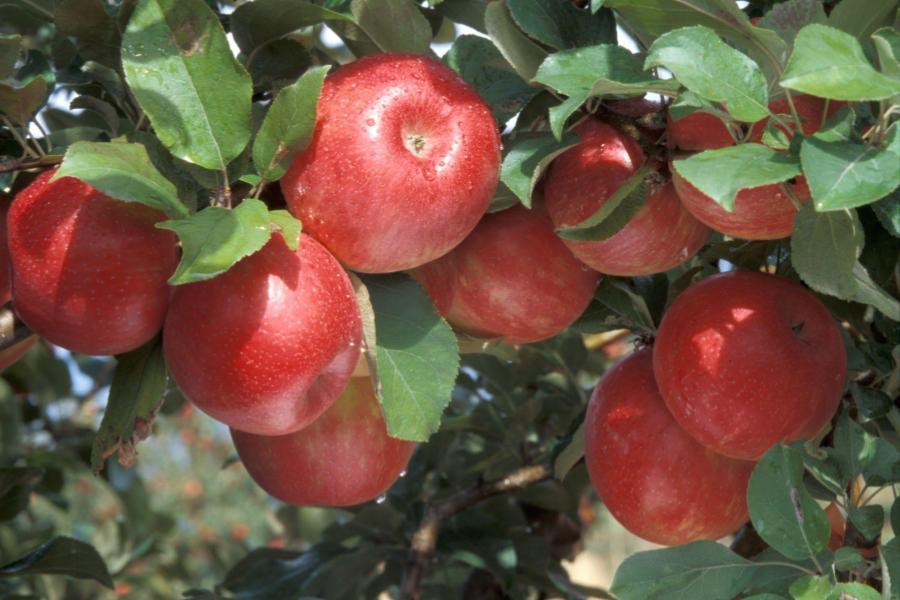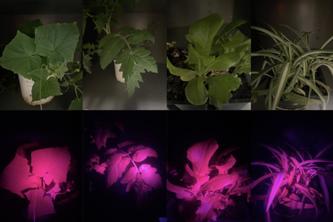
MINNEAPOLIS/ST. PAUL (09/22/2022) — If you enjoy a Honeycrisp, Haralson, SweeTango or First Kiss apple at your local orchard or farm stand this fall, you can thank the University of Minnesota apple breeding program for putting it there.
For the past four decades, Jim Luby, a professor in the College of Food, Agricultural and Natural Resource Sciences, and researcher David Bedford have led the U of M apple breeding program.
With apple season now in full swing, Professor Luby answers questions about the history of Minnesota’s apples and the University’s apple breeding program.
Q: Why did apple breeding begin in Minnesota?
Prof. Luby: There’s a reason you don’t see the apples you buy at the grocery store — Red Delicious, Golden Delicious, Gala, Fuji and Granny Smith — at your local orchard. Those varieties won’t grow in Minnesota. In fact, most of the apples grown worldwide won’t grow here because they can't thrive in the harsh conditions of extremely cold winters.
That’s why in the early 1900s, University of Minnesota researchers began developing cold hardy, great tasting apples in order to bring a sustainable commercial apple industry to the state.
The apple breeding program released its first superstar, the Haralson, 100 years ago — and many of the basics of apple breeding haven’t changed since.
Q: How does apple breeding work?
Prof. Luby: Researchers identify parent apples with characteristics they’d like to combine. For example, one parent may be disease resistant but not crisp and the other parent may be crisp but not disease resistant. The parents are crossed with the goal of developing a new cultivar that is both disease resistant and crisp.
When the trees bear fruit is when the real evaluation begins. Researchers taste the fruit of each tree — up to 600 apples each day — and decide if each one is worth keeping around or not. Very few of the thousands of apples that get tasted each growing season make it past the first round of tasting — typically only 10 to 12 each year.
The best selections make it through even more testing and are released to the public. From initial cross to fruit on the supermarket shelf or at your farmers’ market takes 20 to 25 years.
Q: How have consumer tastes changed over time?
Prof. Luby: Haralson was considered a great tasting apple in its time and is still grown in Minnesota, but it likely wouldn’t make it past the first round of tasting today. It’s an exceptionally cold-hardy tree that produces fruit with a firm texture and a complex tart flavor. While that made it a hit in Minnesota for almost 80 years, it lacks a characteristic that consumers have come to expect since Honeycrisp’s release - crispness. Consumers now expect all apples to have Honeycrisp’s trademark crispness. And apple breeders around the world have taken notice.
Q: What will be the legacy of the Honeycrisp apple?
Prof. Luby: I think what we're going to see as part of the great legacy of Honeycrisp is that a lot of the new varieties that are now coming out and coming to your supermarket are actually the children of Honeycrisp. It's been used a lot in breeding programs, not only here in the United States, but in Europe and China as well.
Several apples developed from Honeycrisp’s genetics are already on the market from other apple breeding programs. The U of M’s most recent apple releases, First Kiss (known as Rave when grown outside of Minnesota) and Triumph, are also children of Honeycrisp, along with SweeTango, which consumers have appreciated for over a decade.
First Kiss/Rave has a similar texture to Honeycrisp, but can be harvested almost a month earlier — a win for both consumers and growers. Triumph carries two forms of genetic resistance to apple scab, making it an appealing option for gardeners and organic growers.
Q: What’s next for Minnesota apples?
Prof. Luby: It’s too early to tell if SweeTango, First Kiss, Triumph or one of the University’s yet-to-be-released apples will surpass Honeycrisp as the top apple variety in Minnesota or rise to Honeycrisp’s level of success. But one thing is certain — the U of M will continue its pioneering of innovative science to fill apple carts, and tantalize taste buds, around the world.
You can learn more about the U of M apple breeding program here.
Jim Luby is a Professor in the Department of Horticultural Science at the University of Minnesota where he has directed research in fruit crops breeding and genetics since 1982. The emphasis of this program is to develop new varieties that combine a satisfying eating experience for the consumer with cold hardiness and disease resistance. His research aims to determine the inheritance of these traits and identify important genetic loci and DNA markers for use in DNA-informed breeding. Under his direction, the University of Minnesota fruit crops breeding program has introduced and commercialized 27 cultivars of apples, wine grapes, blueberries, strawberries, and other fruits. Luby and Senior Research Fellow David Bedford have worked closely together to lead the U of M apple breeding program for the last 40 years. Bedford’s work is directed at the development of new apple cultivars through conventional breeding and the use of marker-assisted selection with special emphasis on the development of "explosively crisp" apples.
-30-
About the College of Food, Agricultural and Natural Resource Sciences
The University of Minnesota’s College of Food, Agricultural and Natural Resource Sciences (CFANS) strives to inspire minds, nourish people, and sustainably enhance the natural environment. CFANS has a legacy of innovation, bringing discoveries to life through science and educating the next generation of leaders. Every day, students, faculty, and researchers use science to address the grand challenges of the world today and in the future. CFANS offers an unparalleled expanse of experiential learning opportunities for students and the community, with 12 academic departments, 10 research and outreach centers across the state, the Minnesota Landscape Arboretum, the Bell Museum of Natural History, and dozens of interdisciplinary centers.
About “Talking...with U of M”
“Talking...with U of M” is a resource whereby University of Minnesota faculty answer questions on current and other topics of general interest. Feel free to republish this content. If you would like to schedule an interview with the faculty member or have topics you’d like the University of Minnesota to explore for future “Talking...with U of M,” please contact University Public Relations at [email protected].
- Categories:
- Agriculture and Environment
- Food





